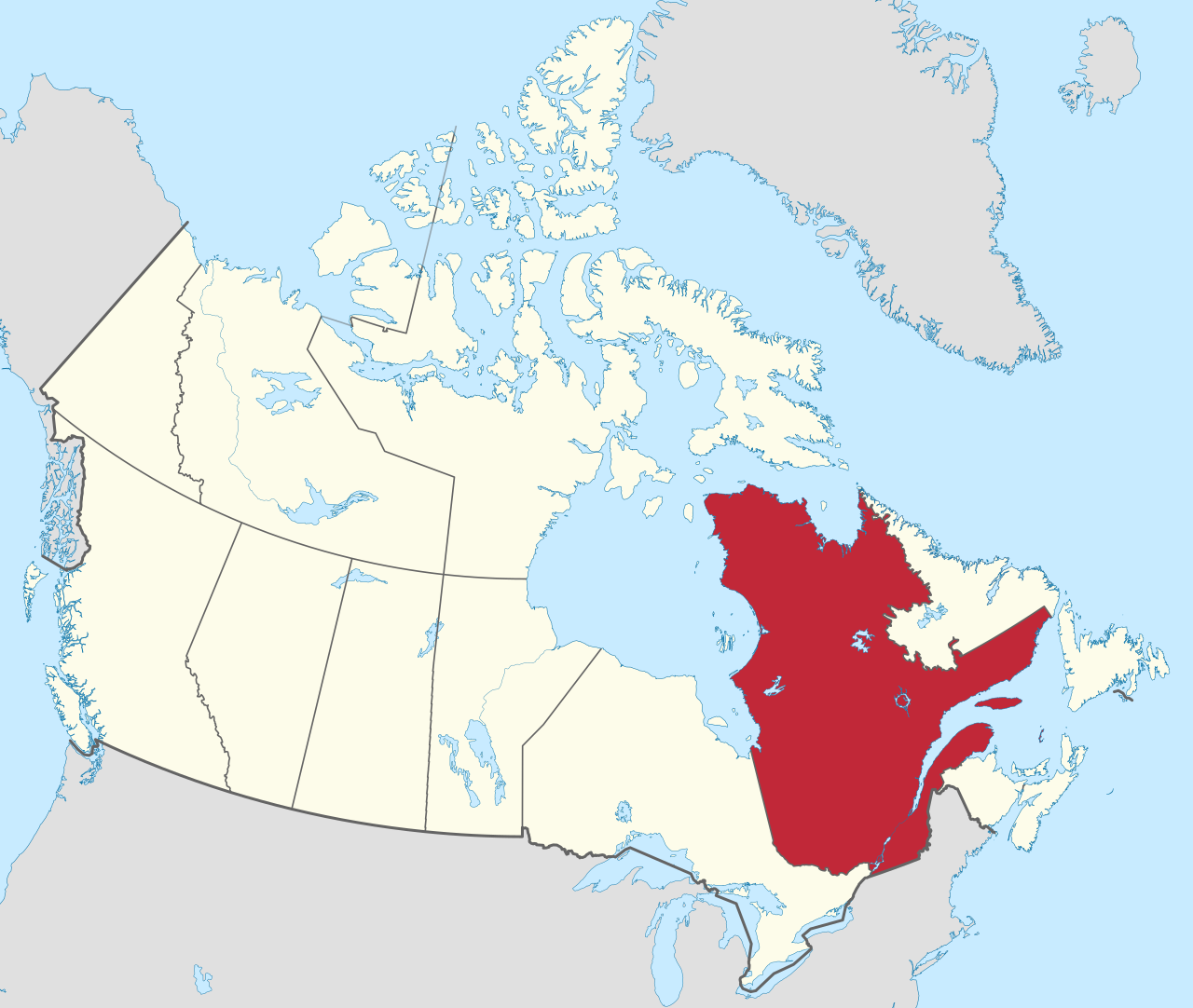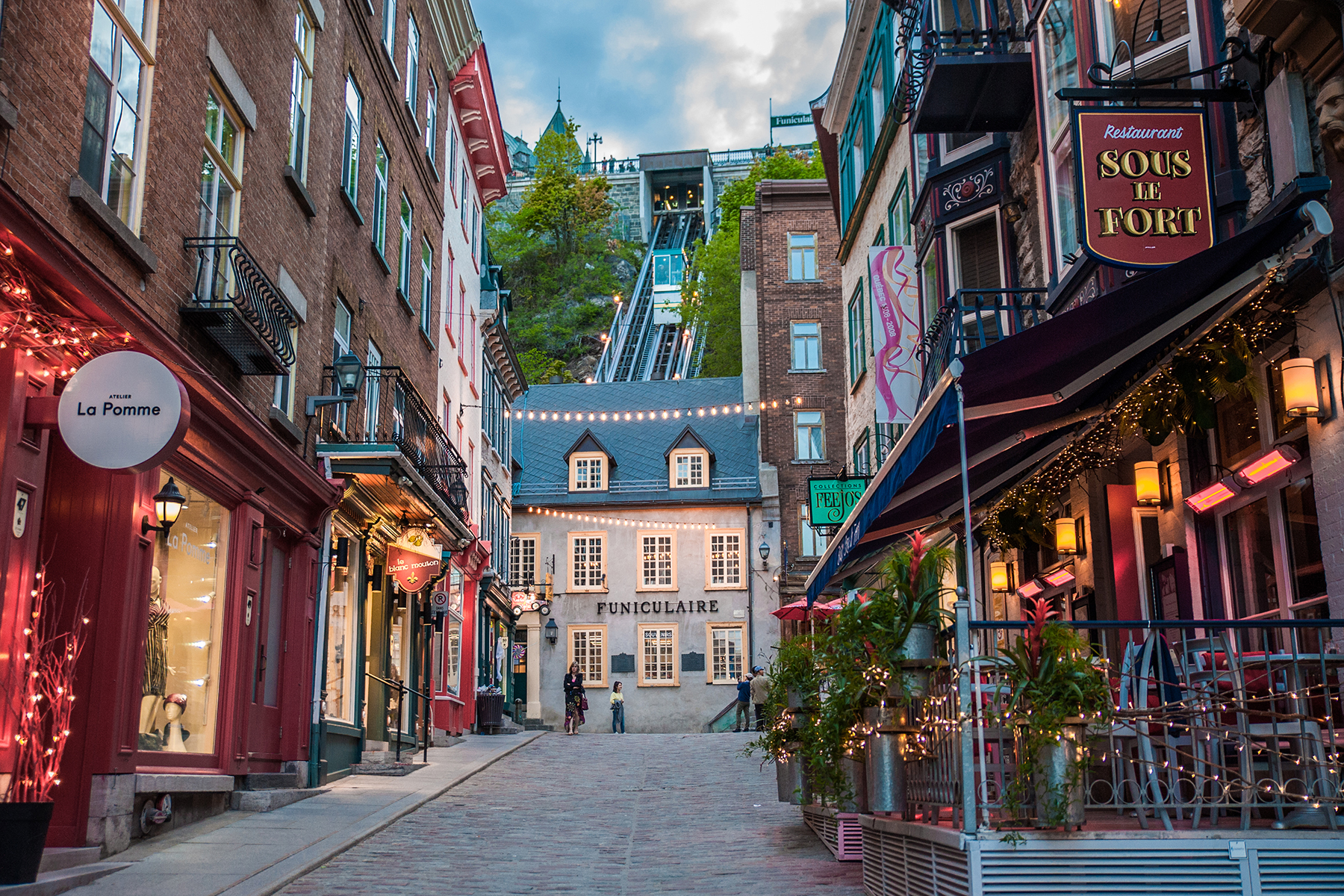QUEBEC

Hoofdstad: Quebec City.
Geschiedenis: Ooit leek Nieuw-Frankrijk voorbestemd het Noord-Amerikaanse continent te gaan beheersen. Aan de Atlantische kust woonden Franse kolonisten, handelaren trokken het binnenland in tot aan de Grote Meren en nog verder. Détroit was een Frans fort, en de rivier de Mississippi was een potentiële verbindings route met de Franse kolonie Louisiana in het zuiden. In het begin werd het leven in de kolonie beheerst door de pelshandel en de maatschappijen die de pelshandel beheersten, met name de Compagnie des Centassociés. Omdat deze maatschappijen onvoldoende kolonisten wisten te werven (het aantal inwoners bedroeg in 1663 slechts 3000) nam koning Lodewijk XIV het bestuur over. Van 1663 tot aan de verovering door de Britten een eeuw later, was Nieuw-Frankrijk een provincie van Frankrijk onder bestuur van de koning. Na de verovering door de Britten werden de hoogste Franse regeringsfunctionarissen naar Frankrijk gestuurd. De habitants bleven, pasten zich aan het nieuwe bestuur aan en zetten hun oude levensstijl voort.
Algemene Informatie: Quebec is de grootste provincie van Canada. Het is de grootste provincie en de op een na grootste qua bevolking. Quebec strekt zich uit van het vruchtbare en dichtbevolkte laagland langs de rivier de St Laurens tot de kust van Straat Hudson, waartussen vele honderden kilometers wouden en toendra liggen. Taalwetten zorgen ervoor dat het Frans visueel domineert op reclame en andere borden, en de langdurige overheersing van Engelstaligen in het zakenleven is beëindigd. Dat betekent echter niet dat je het Frans machtig moet zijn om je in Quebec op je gemak te voelen; vrijwel iedereen verstaat en spreekt Engels.
Aantal inwoners en afkomst: Met ongeveer 8,5 miljoen inwoners is Quebec de tweede dichtsbevolkte provincie van Canada. Ontario en Quebec waren altijd de twee meest bevolkte provincies in Canada, met op elk moment meer dan 60% van de bevolking. De meest voorkomende etnische afkomst zijn: Canadees: 60,1%, Frans: 28,8%, Iers: 5,5% en 5.6% overige. Met zijn 1,6 miljoen inwoners is Montreal de grootste stad, gevolgd door Quebec City met ongeveer 516.000 inwoners.
Religie: De meerderheid van de Quebecse religieuzen is Rooms-katholiek. Belangrijke kleinere religies die in Quebec voorkomen zijn protestantisme, jodendom, islam, boeddhisme en Chinees.
Taal: Frans is de enige officiële taal van Quebec maar in de toeristische gedeeltes wordt ook Engels gesproken. Zo'n 8% van de Quebecse bevolking hebben het Engels als moedertaal. De Engelstaligen wonen vooral in het centrum van de stad Montréal en in de regio rond de zuidelijke plaats Pontiac. Ook in het uiterste oosten van de provincie, richting de grens met Labrador, vormen de Engelstaligen een meerderheid.
Tijdsverschil: Eastern Standard Time (EST). 6 uur vroeger dan Nederland.
Klimaat: Doordat de provincie Quebec een groot gebied omvat, zijn er grote verschillen in temperatuur. Het zuiden, waar de bevolkingsdichtheid het hoogst is, heeft een landklimaat met vier seizoenen: hete zomers en koude winters met veel sneeuw en regen. De in het midden gelegen regio heeft langere winters en korte koele zomers. Het uiterste noorden heeft een Arctisch klimaat, met zeer koude winters en permanent bevroren gebieden. De winter duurt in het zuiden zo'n vijf maanden en in het noorden zo'n acht maanden. Het temperatuurverschil tussen deze twee winters kan oplopen tot 25 graden.
Economie: De St. Lawrence River Valley is een vruchtbare landbouw-regio met onder meer zuivelproducten, fruit, groenten, ganzelever, ahornstroop (Quebec is de grootste producent ter wereld) en een grote veestapel. Er is een sterke concentratie van high-tech industrieën rond Montreal, waaronder verschillende luchtvaart maatschappijen. Grote videogame-bedrijven zoals Electronic Arts en Ubisoft hebben studio's in Montreal. Ook het toerisme speelt een belangrijke rol, vooral steden zoals Montreal en Quebec City zijn erg intrek. De omgeving van Mont Tremblant wordt ook druk bezocht, het is een zomer en winter bestemming.

Capital: Quebec City.
History: At one time, New France seemed destined to rule the North American continent. On the Atlantic coast, French settlers lived, traders went into the inland of the great lakes and even further. Détroit was a French fortress, and the Mississippi River was a potential connection route with the French Colony Louisiana in the South. In the beginning, life in the colony was governed by the Pels trade and the companies that merge the Pels trade, in particular the Compagnie des Centassociés. Because these companies did not want to recruit enough settlers (the number of inhabitants in 1663 were only 3000) King Louis XIV took over the board. From 1663 to the conquest by the Britisch a century later, New France was a province under the king's administration. After the conquest by the Britisch, the highest French government officials were sent to France. The habitants continued to adapt to the new board and continue their old lifestyle.
General Information: Quebec is Canada's largest province. It is the largest province by area and the second-largest by population. Quebec stretches from the fertile and densely populated lowlands along the St Laurens River to the Hudson Strait coast, which lie between many hundreds of miles of forest and tundra. Language laws allow French to visually dominate advertisements and other signs, ending the long-standing domination of English speakers in business. That doesn't mean you have to be fluent in French to feel comfortable in Quebec, however, almost everyone understands and speaks English.
Number of population and descent: With approximately 8.5 million inhabitants, Quebec is Canada's second most populous province. Ontario and Quebec have always been the two most populous provinces in Canada, housing over 60% of the population at any time. The most common ethnic origins are: Canadian: 60.1%, French: 28.8%, Irish: 5.5% and 5.6% others. With its 1.6 million inhabitants, Montreal is the largest city, followed by Quebec City with approximately 516,00 inhabitants.
Religion: The majority of Quebec's religious are Roman Catholic. Major minor religions found in Quebec include Protestantism, Judaism, Islam, Buddhism, and Chinese.
Language: French is the only official language of Quebec, but English is also spoken in the tourist areas. About 8% of the Quebec population is native English. The English speakers mainly live in the center of the city of Montreal and in the region around the southern city of Pontiac. Also in the far east of the province, towards the border with Labrador, the English speakers form a majority.
Time difference: Eastern Standard Time (EST). 6 hours earlier than the Netherlands.
Climate: Because the province of Quebec covers a large area, there are large differences in temperature. The south, where the population density is highest, has a continental climated with four seasons: hot summers and cold winters with lots of snow and rain. The central region has longer winters and short cool summers. The far north has an Arctic climate, with very cold winters and permanently frozen areas. In the south winter lasts about five months and in the north about eight months. The temperature difference between these two winters can reach 25 degrees.
Economy: The St. Lawrence River Valley is a fertile agricultural region with dairy products, fruit, vegetables, geese liver, Ahorn syrup (Quebec is the largest producer in the world) and a large livestock. There is a strong concentration of high-tech industries around Montreal, including various aviation companies. Large video game companies such as Electronic Arts and Ubisoft have studios in Montreal. Also, tourism plays an important role, especially cities such as Montreal and Quebec City are very retracted. The Mont Tremblant area is also visited, it is a summer and winter destination.
.jpg)
@MK